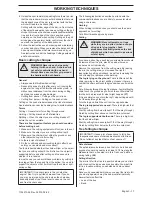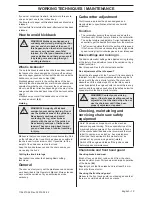
WORKING TECHNIQUES
18 – English
1154212-26 Rev.3 2012-02-22
• Wind direction
• Arrangement of branches
• Weight of snow
• Obstacles within the reach of the tree: for example,
other trees, power lines, roads and buildings.
• Look for signs of damage and rot in the stem, this makes
it more probably that the tree will break and start to fall
before you expect it to.
You may find you are forced to let the tree fall in its natural
direction because it is impossible or dangerous to try to
make it fall in the direction you first intended.
Another very important factor, which does not affect the
felling direction but does affect your safety, is to make sure
the tree has no damaged or dead branches that might
break off and hit you during felling.
The main point to avoid is letting the tree fall onto another
tree. It is very dangerous to remove a trapped tree and
there is high accident risk. See instructions under the
heading Freeing a tree that has fallen badly.
Clearing the trunk and preparing your retreat
Delimb the stem up to shoulder height. It is safer to work
from the top down and to have the tree between you and
the saw.
Remove any undergrowth from the base of the tree and
check the area for obstacles (stones, branches, holes, etc.)
so that you have a clear path of retreat when the tree starts
to fall. Your path of retreat should be roughly 135 degrees
away from the intended felling direction. (39)
1 Danger zone
2 Retreat path
3 Felling direction
Felling
Felling is done using three cuts. First you make the
directional cuts, which consist of the top cut and the bottom
cut, then you finish with the felling cut. By placing these
cuts correctly you can control the felling direction very
accurately.
Directional cuts
To make the directional cuts you begin with the top cut.
Stand to the right of the tree and cut on the pull stroke.
Next make the bottom cut so that it finishes exactly at the
end of the top cut. (40)
The directional cuts should run 1/4 of the diameter through
the trunk and the angle between the top cut and bottom cut
should be 45
°
.
The line where the two cuts meet is called the directional
cut line. This line should be perfectly horizontal and at right
angles (90
°
) to the chosen felling direction. (41)
Felling cut
The felling cut is made from the opposite side of the tree
and it must be perfectly horizontal. Stand on the left side of
the tree and cut on the pull stroke.
Make the felling cut about 3-5 cm (1.5-2 inches) above the
bottom directional cut.
Set the spike bumper (if one is fitted) just behind the felling
hinge. Use full throttle and advance the chain/bar slowly
into the tree. Make sure the tree does not start to move in
the opposite direction to your intended felling direction.
Drive a wedge or breaking bar into the cut as soon as it is
deep enough. (42)
Finish the felling cut parallel with the directional cut line so
that the distance between them is at least 1/10 of the trunk
diameter. The uncut section of the trunk is called the felling
hinge.
The felling hinge controls the direction that the tree falls in.
(43)
All control over the felling direction is lost if the felling hinge
is too narrow or non-existent, or if the directional cuts and
felling cut are badly placed.
When the felling cut and directional cut are complete the
tree should start to fall by itself or with the aid of a felling
wedge or breaking bar.
We recommend that you use a bar that is longer than the
diameter of the tree, so that you can make the felling cut
and directional cuts with single cutting strokes. See
instructions under the heading Technical data section to
find out which lengths of bar are recommended for your
saw.
There are methods for felling trees with a diameter larger
than the bar length. However these methods involve a
much greater risk that the kickback zone of the bar will
come into contact with the tree.
Freeing a tree that has fallen badly
Freeing a ”trapped tree”
It is very dangerous to remove a trapped tree and there is
high accident risk.
Never try to fell the tree that is trapped.
Never work in the risk zone of the hanging trapped tree.
The safest method is to use a winch.
• Tractor-mounted
• Portable
Cutting trees and branches that are in tension
Preparations: Work out which side is in tension and where
the point of maximum tension is (i.e. where it would break
if it was bent even more).
Decide which is the safest way to release the tension and
whether you are able to do it safely. In complicated
situations the only safe method is to put aside your chain
saw and use a winch.
General advice:
Position yourself so that you will be clear of the tree or
branch when the tension is released.
Make one or more cuts at or near the point of maximum
tension. Make as many cuts of sufficient depth as
necessary to reduce the tension and make the tree or
branch break at the point of maximum tension.
Never cut straight through a tree or branch that is in
tension!
IMPORTANT! During critical felling operations, hearing
protectors should be lifted immediately when sawing is
completed so that sounds and warning signals can be
heard.
!
WARNING! Unless you have special
training we advise you not to fell trees
with a diameter larger than the bar
length of your saw!












































